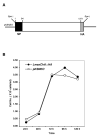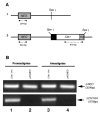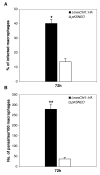Molecular characterization, expression, and in vivo analysis of LmexCht1: the chitinase of the human pathogen, Leishmania mexicana
- PMID: 15561707
- PMCID: PMC2839926
- DOI: 10.1074/jbc.M412299200
Molecular characterization, expression, and in vivo analysis of LmexCht1: the chitinase of the human pathogen, Leishmania mexicana
Abstract
Chitinases have been implicated to be of importance in the life cycle development and transmission of a variety of parasitic organisms. Using a molecular approach, we identified and characterized the structure of a single copy LmexCht1-chitinase gene from the primitive trypanosomatid pathogen of humans, Leishmania mexicana. The LmexCht1 encodes an approximately 50 kDa protein, with well conserved substrate binding and catalytic domains characteristic of members of the chitinase-18 protein family. Further, we showed that LmexCht1 mRNA is constitutively expressed by both the insect vector (i.e. promastigote) and mammalian (i.e. amastigote) life cycle developmental forms of this protozoan parasite. Interestingly, however, amastigotes were found to secrete/release approximately >2-4-fold higher levels of chitinase activity during their growth in vitro than promastigotes. Moreover, a homologous episomal expression system was devised and used to express an epitope-tagged LmexCht1 chimeric construct in these parasites. Expression of the LmexCht1 chimera was verified in these transfectants by reverse transcription-PCR, Western blots, and indirect immunofluorescence analyses. Further, results of coupled immunoprecipitation/enzyme activity experiments demonstrated that the LmexCht1 chimeric protein was secreted/released by these transfected L. mexicana parasites and that it possessed functional chitinase enzyme activity. Such transfectants were also evaluated for their infectivity both in human macrophages in vitro and in two different strains of mice. Results of those experiments demonstrated that the LmexCht1 transfectants survived significantly better in human macrophages and also produced significantly larger lesions in mice than control parasites. Taken together, our results indicate that the LmexCht1-chimera afforded a definitive survival advantage to the parasite within these mammalian hosts. Thus, the LmexCht1 could potentially represent a new virulence determinant in the mammalian phase of this important human pathogen.
Figures








Similar articles
-
Identification, characterization, and expression of a unique secretory lipase from the human pathogen Leishmania donovani.Mol Cell Biochem. 2010 Aug;341(1-2):17-31. doi: 10.1007/s11010-010-0433-6. Epub 2010 Mar 27. Mol Cell Biochem. 2010. PMID: 20349119 Free PMC article.
-
Leishmania chitinase facilitates colonization of sand fly vectors and enhances transmission to mice.Cell Microbiol. 2008 Jun;10(6):1363-72. doi: 10.1111/j.1462-5822.2008.01132.x. Epub 2008 Feb 19. Cell Microbiol. 2008. PMID: 18284631 Free PMC article.
-
Overexpression of the Leishmania amazonensis Ca2+-ATPase gene lmaa1 enhances virulence.Cell Microbiol. 2002 Feb;4(2):117-26. doi: 10.1046/j.1462-5822.2002.00175.x. Cell Microbiol. 2002. PMID: 11896767
-
Glucose Transporters and Virulence in Leishmania mexicana.mSphere. 2018 Aug 1;3(4):e00349-18. doi: 10.1128/mSphere.00349-18. mSphere. 2018. PMID: 30068561 Free PMC article.
-
Cysteine peptidases as virulence factors of Leishmania.Curr Opin Microbiol. 2004 Aug;7(4):375-81. doi: 10.1016/j.mib.2004.06.010. Curr Opin Microbiol. 2004. PMID: 15358255 Review.
Cited by
-
Diverse viscerotropic isolates of Leishmania all express a highly conserved secretory nuclease during human infections.Mol Cell Biochem. 2012 Feb;361(1-2):169-79. doi: 10.1007/s11010-011-1101-1. Epub 2011 Oct 22. Mol Cell Biochem. 2012. PMID: 22020747 Free PMC article.
-
Dataset on recombinant expression of an ancient chitinase gene from different species of Leishmania parasites in bacteria and in Spodoptera frugiperda cells using baculovirus.Data Brief. 2020 Sep 2;32:106259. doi: 10.1016/j.dib.2020.106259. eCollection 2020 Oct. Data Brief. 2020. PMID: 32964080 Free PMC article.
-
Non-Vesicular Lipid Transport Machinery in Leishmania donovani: Functional Implications in Host-Parasite Interaction.Int J Mol Sci. 2023 Jun 26;24(13):10637. doi: 10.3390/ijms241310637. Int J Mol Sci. 2023. PMID: 37445815 Free PMC article. Review.
-
Intracellular Survival of Leishmania major Depends on Uptake and Degradation of Extracellular Matrix Glycosaminoglycans by Macrophages.PLoS Pathog. 2015 Sep 3;11(9):e1005136. doi: 10.1371/journal.ppat.1005136. eCollection 2015 Sep. PLoS Pathog. 2015. PMID: 26334531 Free PMC article.
-
Molecular and Immunological Properties of a Chimeric Glycosyl Hydrolase 18 Based on Immunoinformatics Approaches: A Design of a New Anti-Leishmania Vaccine.ACS Pharmacol Transl Sci. 2024 Dec 31;8(1):78-96. doi: 10.1021/acsptsci.4c00341. eCollection 2025 Jan 10. ACS Pharmacol Transl Sci. 2024. PMID: 39816796
References
-
- UNDP/WorldBank/WorldHealthOrganization . Tropical Disease Resaerch: Progress 1997-1998: Fourteenth Programme Report of UNDP/World Bank/WHO Special Programme for Research and Training in Tropical Diseases. World Health Organization; Geneva, Switzerland: 1999.
-
- Sacks D, Kamhawi S. Annu Rev Microbiol. 2001;55:453–483. - PubMed
-
- Schlein Y, Jacobson RL, Shlomai J. Proc R Soc Lond B Biol Sci. 1991;245:121–126. - PubMed
Publication types
MeSH terms
Substances
Associated data
- Actions
Grants and funding
LinkOut - more resources
Full Text Sources
Molecular Biology Databases

